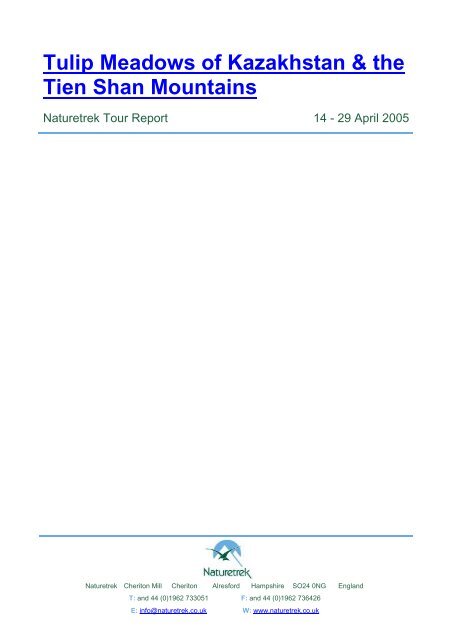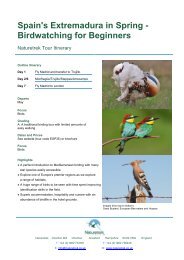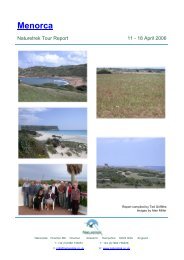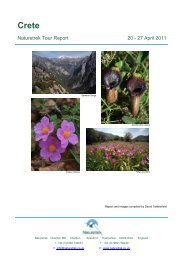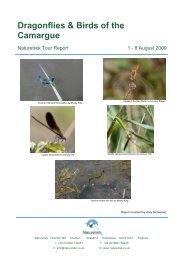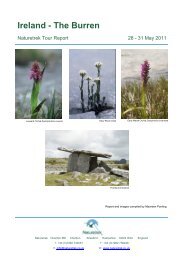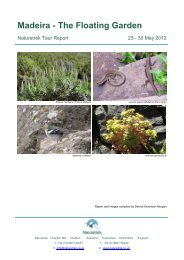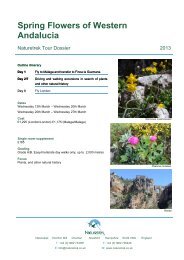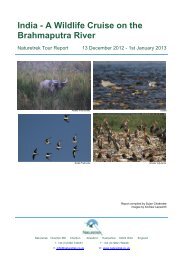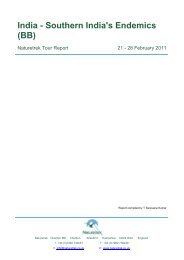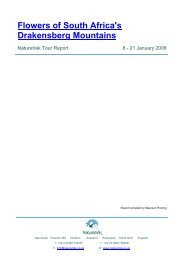Tulip Meadows of Kazakhstan & The Tien Shan ... - Naturetrek
Tulip Meadows of Kazakhstan & The Tien Shan ... - Naturetrek
Tulip Meadows of Kazakhstan & The Tien Shan ... - Naturetrek
You also want an ePaper? Increase the reach of your titles
YUMPU automatically turns print PDFs into web optimized ePapers that Google loves.
<strong>Tulip</strong> <strong>Meadows</strong> <strong>of</strong> <strong>Kazakhstan</strong> & the<br />
<strong>Tien</strong> <strong>Shan</strong> Mountains<br />
<strong>Naturetrek</strong> Tour Report 14 - 29 April 2005<br />
<strong>Naturetrek</strong> Cheriton Mill Cheriton Alresford Hampshire SO24 0NG England<br />
T: and 44 (0)1962 733051 F: and 44 (0)1962 736426<br />
E: info@naturetrek.co.uk W: www.naturetrek.co.uk
Tour Report <strong>Tulip</strong> <strong>Meadows</strong> <strong>of</strong> <strong>Kazakhstan</strong> & the <strong>Tien</strong> <strong>Shan</strong> Mountains<br />
Leaders: Anna Ivanshenko<br />
Neil Anderson<br />
Participants: Mary Moore<br />
Peter Newton<br />
Kathleen Newton<br />
Lynne Chapman<br />
John Chapman<br />
Pat Whately<br />
Amanda Vines<br />
Stephanie Littlewood<br />
Day 1 Thursday 14 April<br />
Heathrow- Frankfurt-Almaty<br />
We all met up on time and departed Heathrow at 07.05 for 90 min. flight to Frankfurt. Here we had time to<br />
peruse the shops before boarding our Almaty bound flight. Both flights and proceeding through customs went<br />
smoothly, so we were able to settle in the Astana International Hotel for good night’s sleep before midnight.<br />
Day 2 Friday 15 April<br />
Lake Kapchagai<br />
Following a good breakfast we departed the hotel in sunshine and greeted by Anna and our translator Rima who<br />
would be with us for a few days. En route we picked up the young Dilyara, her first encounter with an English<br />
group, who would be with us for the whole trip as an interpreter.<br />
We drove c.80km NE from Almaty to Lake Kapchagai which is fed by the River Ili.After a brief stop en route<br />
we arrived at the security check to explore the hillside where many stocky <strong>Tulip</strong>a alberti were photographed.<br />
Other highlights were the blue campanulate flowers <strong>of</strong> Ixiolirion tataricum, 2spp <strong>of</strong> poppy:red Papaver pavoninum<br />
and the unusual yellow flowers <strong>of</strong> Hypecoum parviflorum and the pink Salsify relative, Tragopogon marginifolius. 3<br />
White Pelicans flew over.<br />
Arriving at the lake we saw many clumps <strong>of</strong> the showy Iris tenuifolia, an abundance <strong>of</strong> yellow <strong>Tulip</strong>a behmiana and<br />
the delicate pale starry flowers <strong>of</strong> T. busheana. <strong>The</strong> petite Fritillaria karelinii was also found here.<br />
A copulating pair <strong>of</strong> Horsfield’s Tortoise provided the faunal highlight <strong>of</strong> the day! We arrived back at the hotel<br />
by 18.00.<br />
© <strong>Naturetrek</strong> December 05 1
<strong>Tulip</strong> <strong>Meadows</strong> <strong>of</strong> <strong>Kazakhstan</strong> & the <strong>Tien</strong> <strong>Shan</strong> Mountains Tour Report<br />
Day 3 Saturday 16 April<br />
Almaty-Kurdai Pass-Merke<br />
We made an early start for the 360km drive to Merke with botanising stops on the way.A roadside stop<br />
dominated by the steppe grass Stipa capillata was inundated by the glorious yellow flowers <strong>of</strong> <strong>Tulip</strong>a<br />
kolpokowskiana.<br />
A close flock <strong>of</strong> c.400 Demoiselle Cranes demanded a second stop and using Neil’s scope all had superb views<br />
as these majestic birds refueled on their northward migration.<br />
Lunch was partaken at the Kurdai Pass, where the banquet was lubricated with tea, vodka and wine!. A colony <strong>of</strong><br />
white Crocus alatavicus was seen by a snow patch. Leontice eversmannii, a showy Berberis relative, was locally common<br />
Probably the highlight here was the exuberant swathe <strong>of</strong> yellows, oranges and reds <strong>of</strong> <strong>Tulip</strong>a ostrowskiana, T.<br />
kolpokowskianaand their hybrids. Six spp <strong>of</strong> Gagea presented I.D challenges while the blue Iris tianschanica and I.<br />
kuschakewiczii were much admired.<br />
We arrived at Merke Sanitorium at c.21.30 for the first <strong>of</strong> 2 nights and were greeted by 20 people “disco<br />
dancing” outside. Conditions were comfortable but basic!<br />
Day 4 Sunday 17 April<br />
Merke<br />
Another glorious day and after a later breakfast drove a couple <strong>of</strong> km to botanise in the hills. A Golden Eagle<br />
passed ahead <strong>of</strong> us as we admired the yellow Juno, Iris orchiodes. <strong>The</strong> delicate <strong>Tulip</strong>a bifloriformis was seen amongst<br />
rocks, but we had to travel much further before we encountered the exquisite T.zenaidae, initially red and yellow<br />
flowers were found, but Anna later discovered a pure red specimen.<br />
A pair <strong>of</strong> Red Marmots provided a delightful diversion from the plants. We then returned for a late lunch.<br />
Following this Uri, our driver, took us about 10km along a challenging road. <strong>The</strong> mountains were dominated by<br />
Juniperus semiglobosa, but the highlight was a mini-meadow <strong>of</strong> Gageas and T. dasystemonoides, a species not found in<br />
the previous couple <strong>of</strong> tours. Both Brown and White-throated Dippers as well as the Blue Whistling Thrush<br />
were observed along the Merkenka River.<br />
Day 5 Monday 18 April<br />
Merke-Aksu Dzabagly<br />
Depating Merke in sunshine at 09.30 we stopped at Kulan Market for browsing and provisions. This was<br />
followed by a cultural stop to inspect the fine mausoleum <strong>of</strong> Aisha Byby which was constructed with local brick<br />
at the end <strong>of</strong> the 11th century, but with some recent restoration. A White-winged Woodpecker here was a bonus.<br />
After lunch we botanised on the dry slopes <strong>of</strong> the Kuyuk Pass. <strong>The</strong>seslopes held good numbers <strong>of</strong> the<br />
architectural Allium karataviense and a few Iris caerulea. Only a couple <strong>of</strong> flowers <strong>of</strong> the latter were seen due to the<br />
ravages <strong>of</strong> sheep.<br />
© <strong>Naturetrek</strong> December 05 2
<strong>Tulip</strong> <strong>Meadows</strong> <strong>of</strong> <strong>Kazakhstan</strong> & the <strong>Tien</strong> <strong>Shan</strong> Mountains Tour Report<br />
Our penultimate stop was c.10km from the guesthouse to inspect the flora by some snowmelt. Here emerged a<br />
stunning garden <strong>of</strong> yellow Eranthis longistipitata, Anemone petiolulosa, Gageas and white Crocus alatavicus. Sheer bliss!<br />
A final stop allowed to see the showy Corydalis sewersowii growing below some bushes. Soon after we were able to<br />
enjoy a hot shower which was most welcome after the very basic conditions at Merke.<br />
Day 6 Tuesday 19th April<br />
Saya Su Gorge<br />
Our first overcast day, we paused near Kuyuk Pass to admire a flock <strong>of</strong> c.2,000 Demoiselle Cranes feeding in<br />
fields, At the pass we stopped to photograph flowering Eremurus lactiflorus.<br />
<strong>The</strong> next gorge was ornithologically rewarding with Short-toed Eagle overhead, a confiding Egyptian Vulture<br />
perched above us, totally indifferent to us, and a pair <strong>of</strong> Eastern Rock Nuthatches feeding young in their mud<br />
nest on the cliff face.<br />
At Saya Su we took lunch on the bus due to the wind. <strong>The</strong> highlights here were the diverse array <strong>of</strong> <strong>Tulip</strong>a greigii<br />
flowers. A smart Tiger Moth, Arctia caja, was discovered by Peter.<br />
On the return to our base we briefly stopped at a lake for some birding . Most notable were the 4 Little Bustards<br />
found in the arid grassland leading to the lake.<br />
Day 7 Wednesday 20th April<br />
Aksu Canyon<br />
We were pleased to see the return <strong>of</strong> clear sunny skies as we made the local trip to Aksu Canyon. Our first pause<br />
was a panoramic one as we peered at the valley to see our and neighbouring villages as well as the Karatau<br />
Mountains opposite.<br />
<strong>The</strong> next two stops were centred around recent snowmelts. Here we encountered the delicate pink flowers <strong>of</strong><br />
Fritillaria stenanthera, many white Scilla puschkinoides and the cream- a pr<strong>of</strong>usion <strong>of</strong> <strong>Tulip</strong>a kaufmanniana in diverse<br />
colours, which had whooping with joy!<br />
Lunch was by the bus at the top <strong>of</strong> the canyon where Booted Eagle, Long-legged Buzzard, Alpine Choughs and<br />
Ravens were soaring and Swallowtails flitted about. Views here are spectacular. <strong>The</strong> descent to the bottom was a<br />
little slippery in places, A good selection <strong>of</strong> Fritillaria sewersowii were admired near the top. Other fine flowers<br />
encountered include <strong>Tulip</strong>a turkestanica, T. greigiiand, Geranium transversale.<br />
Standing on the wooden bridge across the fast-flowing river (Aksu = white river) we could feel its energy.<br />
Amanda and Stephanie had a brief paddle at the edge. John spotted a Camberwell Beauty which briefly alighted<br />
on the bridge.<br />
© <strong>Naturetrek</strong> December 05 3
<strong>Tulip</strong> <strong>Meadows</strong> <strong>of</strong> <strong>Kazakhstan</strong> & the <strong>Tien</strong> <strong>Shan</strong> Mountains Tour Report<br />
<strong>The</strong> hard work <strong>of</strong> the 1000m ascent was tiring, but the whole venture down the canyon and back was a<br />
tremendous adventure, which no one regretted.<br />
Day 8 Thursday 21st April<br />
Mashat-Red Hill- Chokpak<br />
En route to Mashat,c.50km from the guest house, we made a photographic stop, as pat was keen to snap one <strong>of</strong><br />
the grand cemeteries.<br />
Mashat has a warm Mediterranean-type climate with vegetation typified by Rosa/Amgdalus shrubs, tall yellow<br />
umbellifers such as Prangos/Ferula, bulbs and annuals. As we drove along the road we could see a mass <strong>of</strong> Ferula<br />
tenuisecta, high held buds <strong>of</strong> Eremurus regelii and blue Ixiolirion tataricum. Pistacio vera was flowering at its northerly<br />
limit and the first yellow blooms were admired on Rosa kokanica.<br />
After lunch we proceeded to Red Hill, where it soon became apparent to the group as to the origin <strong>of</strong> the name:<br />
a hillside carpeted in a million red <strong>Tulip</strong>a greigii- an awesome spectacle, where innumerable pictures were taken.<br />
As a contrast we met Andre and his team at Chokpak ringing station. It had been a quiet day at the giant<br />
heligoland trap with just 1 bird caught, though during our stay a Magpie doubled the day’s tally, which we saw<br />
being processed. Andre informed us that sometimes a couple <strong>of</strong> thousand birds per day could be trapped with an<br />
all time record <strong>of</strong> 14,000 in a day. Following hospitality at Chokpak we retired to the guest house.<br />
Day 9 Friday 22nd April<br />
Kyzyl Zhar<br />
With more warm sunshine we had a local visit to Kyzyl Zhar and the Dzabagly River, with a chorus <strong>of</strong> Marsh<br />
Frogs greeting us.<br />
<strong>The</strong> gentle ascent was dominated by junipers and more open areas. Many patches <strong>of</strong> T. kaufmanniana were<br />
enjoyed as well as hybrids with T. greigii. An outstanding area was accidentally discovered by John in pursuit <strong>of</strong> a<br />
Siberian Stonechat. Here were tall spires <strong>of</strong> Megacarpea orbiculata, beautiful yellow form <strong>of</strong> T. turkestanica, a few<br />
Crocus Eranthis and Gymnospermium alberti.<br />
Lunch was at half-way house where lunch had been transported by the horse-man. As we sat a Blue-capped<br />
Redstart sang from the small Robinia shading us. Rufous-naped and Yellow-breasted Azure Tits were also in the<br />
vicinity. Following lunch and a siesta we went a little farther to see the attractive waterfall.<br />
While Lynn seeked a private moment she inadvertently discovered a venomous Haly’s Pit-viper, which gave<br />
good views.<br />
<strong>The</strong> day concluded with Peter giving astronomy lessons with Neil’s scope after dinner, with Jupiter and its 3<br />
moons observed.<br />
© <strong>Naturetrek</strong> December 05 4
<strong>Tulip</strong> <strong>Meadows</strong> <strong>of</strong> <strong>Kazakhstan</strong> & the <strong>Tien</strong> <strong>Shan</strong> Mountains Tour Report<br />
Day 10 Saturday 23rd April<br />
Taldybulak<br />
We followed the stream up Taldybulak at the rear <strong>of</strong> the guest house in overcast and showery conditions. At<br />
times crossing the fast-flowing stream had us wondering if Anna was preparing us for the Aksu commandos! We<br />
encountered many by now familiar plants. Higher up where we took lunch was a stunning collection <strong>of</strong><br />
Iridodictyum kolpokowskianum.<br />
Probably the highlight <strong>of</strong> the day for most was a family group <strong>of</strong> Siberian Ibex, which gave prolonged views on<br />
the rock face.<br />
Not wishing to get wet again Mary made her debut on horse back for the descent, aided by ranger Eric. He also<br />
showed most <strong>of</strong> the group around the reserve museum before dinner.<br />
Day 11 Sunday 24th April<br />
Aksu-Sairyaigyr<br />
Our sad farewells were bade to the friendly guest house staff as we departed for the cabins at the picturesque<br />
Sairyaigyr Gorge. A brief stop was made in Aksu bazaar where food and scarves were purchased.<br />
Lunch was had by the Sairam Su where Brown Dipper and elusive White-crowned Penduline Tit were seen.<br />
Unexpectedly we had another lunch as we reached our camp- nobody starves here!<br />
A late afternoon stroll provided us with our first sightings <strong>of</strong> deep yellow Iris tubergeniana and Colchicum luteum.<br />
Day 12 Monday 25th April<br />
Sairyaigyr Gorge<br />
Today was spent exploring this scenic gorge on foot, generally easygoing apart from a rickety wooden bridge<br />
over the river. <strong>The</strong> campsite owner provided a rope to assist us on our return.<br />
<strong>The</strong> number <strong>of</strong> new plants was few, but we continued to delight in the many new sports <strong>of</strong> T. kaufmanniana.<br />
Another 3 new spp <strong>of</strong> Gagea were discovered, adding to our confusion over this genus. <strong>The</strong> floral tapestry was<br />
also enhanced with good numbers <strong>of</strong>, C. luteum Crocus, Corydalis and T.turkestanica.<br />
Few birds were seen, though Rufous- naped Tits could be heard and Amanda was pleased that she found and<br />
identified a Golden Eagle. Two Camberwell Beauties feeding on a sap run provided good photo opportunities.<br />
After lunch we witnessed the devastation <strong>of</strong> recent avalanches which had cut a swathe through the junipers. A<br />
group <strong>of</strong> a pale form <strong>of</strong> T. dasystemonoides gave the final floral delight <strong>of</strong> the day.<br />
© <strong>Naturetrek</strong> December 05 5
<strong>Tulip</strong> <strong>Meadows</strong> <strong>of</strong> <strong>Kazakhstan</strong> & the <strong>Tien</strong> <strong>Shan</strong> Mountains Tour Report<br />
Day 13 Tuesday 26th April<br />
Sairyaigyr-overnight sleeper<br />
During the morning we spent our final couple <strong>of</strong> hours exploring the gorge. Amongst the new finds were the<br />
erect flowering stems <strong>of</strong> white Astragalus nuciferus and the more compact blue and white A. skorniakovii, an aptly<br />
named crucifer, Chalcanthus renifolius with maroon and pale flowers and our final new Juno, the pale Iris<br />
capnoides.<br />
After a hearty lunch we were taken to Shimkent Station where we departed on the sleeperat 17.56. From the<br />
train we were able to view places that we had visited such as Aksu, Mashat and Chokpak.<br />
Day 14 Wednesday 27th April<br />
Almaty-Observatory<br />
We arrived promptly at Almaty at 09.00 and were whisked to the Astana International Hotel for breakfast.<br />
<strong>The</strong>reafter lay the challenging drive in the 4WD bus to the old Russian observatory, 2700m up in the western<br />
<strong>Tien</strong> <strong>Shan</strong> Mountains, resembling something out <strong>of</strong> a1970’s sci-fi movie!<br />
An initial stop when the bus had problems resultedin the fortuitous discovery <strong>of</strong> 107 T. dasystemon yellow<br />
flowers.<br />
Reaching the dam <strong>of</strong> Almaty Lake we took a walk which was both botanically and ornithologically rewarding.<br />
Previous springs had seen this area snow covered, but now resembled an alpine garden with pink Primula algida,<br />
T.dasystemon, T. heterophylla and single stunners <strong>of</strong> purple Viola altaica and Allium atrosanguineum.<br />
Birdwise we had a small mixed feeding flock <strong>of</strong> Red-fronted Serins and Plain Mountain Finches, whilst in a<br />
nearby small bare bush sang a Black-throated Accentor. A pair <strong>of</strong> Himalayan Snowcock gave brief flight views,<br />
but were heard frequently, but the real thrill was seeing an Ibisbill feeding in the feeder streams and several brief<br />
flight views as it chased <strong>of</strong>f Crows, presumably because it had a nearby nest. With our first Grey Marmot calling<br />
this proved a very exciting and productive stop.<br />
Day 15 Thursday 28th April<br />
Observatory-Almaty<br />
Our good luck continued as cloudless blue skies and no wind dominated unlike previous trips and we had our<br />
last exploration between the observatory and the dam. A pair <strong>of</strong> Golden Eagles majestically soared over the<br />
snowy peaks.<br />
Additional plants encountered included the compact alpine Erytrichium villosa, pale Pulsatilla campanella, minute<br />
blue flower <strong>of</strong> Gentiana kareliniiand the showy yellow legume <strong>The</strong>rmopsis alpina.<br />
Following lunch we began the slow descent to Almaty with a couple <strong>of</strong> photo-oppurtunity and a botanical stop<br />
en route.<br />
© <strong>Naturetrek</strong> December 05 6
<strong>Tulip</strong> <strong>Meadows</strong> <strong>of</strong> <strong>Kazakhstan</strong> & the <strong>Tien</strong> <strong>Shan</strong> Mountains Tour Report<br />
After checking back in the hotel all but John and Lynne had a city tour with the knowledgeable Rima. We visited<br />
the Green Market where the gastronomic delights were sampled and purchased. <strong>The</strong> stunning Russian Orthodox<br />
Church in the central leafy park was visited with a service in progress. As we returned to our bus we admired the<br />
impressive war memorial which was being smartened up for the May Day celebrations<br />
At 19.00 we took our final dinner in the hotel with Anna and Rima as our guests.<br />
Day 16 Friday 29th April<br />
Almaty-Frankfurt-Heathrow<br />
After a few hours sleep we were picked up from the hotel at 01.45 and driven to the airport. We were processed<br />
efficiently with no time sitting around and departed 03.20 for the journey to Frankfurt. As we arrived a damp<br />
dawn rose, while we had 90 minutes to kill before the final leg <strong>of</strong> our journey to Heathrow. Conditions in<br />
London were better than in Frankfurt with warm sunshine. Landing around 09.00 we said our fond farewells<br />
and a reunion planned for the summer to reminisce over this superb trip and compare photos.<br />
© <strong>Naturetrek</strong> December 05 7
Tour Report <strong>Tulip</strong> <strong>Meadows</strong> <strong>of</strong> <strong>Kazakhstan</strong> & the <strong>Tien</strong> <strong>Shan</strong> Mountains<br />
Flora list<br />
Monocots<br />
Alliaceae<br />
Allium atrosanguineum<br />
A. drobovii<br />
A. eriocoleum<br />
A. fetisovii<br />
A. karataviense<br />
A.pallasi<br />
A. scabriscarpum<br />
A.sewersowii<br />
Asparagus persicus<br />
Amaryllidaceae<br />
Ungernia sewersowii<br />
Araceae<br />
Arumkorolkowii<br />
Eminium regelii<br />
Asphodelaceae<br />
Eremurus cristatus<br />
E. inderiensis<br />
E. lactiflorus<br />
E. regelii<br />
E. sogdianus<br />
Colchicaceae<br />
Colchicum luteum<br />
Convallariaceae<br />
Polygonatum sewersowii<br />
Cyperaceae<br />
Carex praecox<br />
C. turkestanica<br />
Hyacinthaceae<br />
Scilla puschkinoides<br />
Iridaceae<br />
Crocus alatavicus<br />
Iridodyctium kolpokowskianum<br />
Iris caerulea<br />
I. capnoides<br />
I. kuschakewiczii<br />
I.orchiodes<br />
I. sogdiana<br />
I. tenuifolia<br />
I. tianschanicus<br />
I. tubergeniana<br />
Ixioliriaceae<br />
Ixiolirion tataricum<br />
Liliaceae<br />
Fritillaria karelinii<br />
F. sewersowii<br />
F. stenanthera<br />
Gagea alberti<br />
G bulbifera<br />
G. chomotovae<br />
G. dshunjarica<br />
G. emarginata<br />
G. filiformis<br />
G. humicola<br />
G. iliensis<br />
G. minutiflora<br />
G. neopopovii<br />
G. olgae<br />
G’ ova<br />
G. popovii<br />
G’ tenera<br />
G. turkestanica<br />
G. vegetata<br />
<strong>Tulip</strong>a alberti<br />
T. behmiana<br />
T’ bifloriformis<br />
T. busheana<br />
T. dasystemon<br />
T. dasystemononoides<br />
T. greigii<br />
T. heterophylla<br />
T. kaufmanniana<br />
T. kolpakowskiana<br />
T. orthopoda<br />
T’ ostrowskiana<br />
T. regelii<br />
T. turkestanica<br />
T. zenaidae<br />
Poaceae<br />
Bromus tectorum<br />
Dactylis glomerata<br />
Festuca sulcata<br />
Hordeum bulbosum<br />
H. crinitum<br />
Lasiorostis splendens<br />
Phragmites australis<br />
Stipa capillata<br />
Dicots<br />
Aceraceae<br />
Acer negundo<br />
A. semenovii<br />
Anarcadiaceae<br />
Pistacio vera<br />
Apiaceae<br />
Aegopodium tadshikorum<br />
Conium maculatum<br />
Ferula karatavica<br />
F. leucographa<br />
F. penninervis<br />
F. pseudoreoselina<br />
F. samarkandica<br />
F. tenuisecta<br />
Muretia transitoria<br />
Oedibasis apiculata<br />
Prangos pabularia<br />
P. uloptera<br />
Scaligera setacea<br />
Scandix pectin-veneris<br />
S. stellata<br />
Screnkiana golickeana<br />
Torilis leptophilum<br />
Vicatia coniifolia<br />
Asteraceae<br />
Achillea filipendulina<br />
A. millefolium<br />
Alphredia nivea Artemisia<br />
absinthium<br />
A. austriaca<br />
A. dracunculus<br />
A. junceum<br />
A. karatavica<br />
A. A. rutifolia<br />
A. santolinifolia<br />
A. sublessingiana<br />
A. terrae-alba<br />
Centaurea squarrosa<br />
C. turkestanica<br />
Cichorium intybus<br />
Cousinia alata<br />
C. alberti<br />
C. karatavica<br />
C.microcarpa<br />
C. sewersowii<br />
C. triflora<br />
C. turkestanica<br />
C. umbrosa<br />
Echinops karatavicus<br />
Handelia trichophylla<br />
Hieracium echiodes<br />
Inula macrophylla<br />
Ligularia karataviense<br />
Olgaea pectinata<br />
Onopordum acanthium<br />
Scorzonera franachetti<br />
Tanacetum pseudoachillea<br />
Taraxacum montanum<br />
T. <strong>of</strong>ficinale agg.<br />
Tragopogon marginifolius<br />
T. krasheninnikovii<br />
Tussilago farfara<br />
Xanthium strumarium<br />
Berberidaceae<br />
Berberis oblonga<br />
B. sphaerocarpa<br />
Gymnospermum alberti<br />
Leontice eversmanii<br />
© <strong>Naturetrek</strong> December 05 8
<strong>Tulip</strong> <strong>Meadows</strong> <strong>of</strong> <strong>Kazakhstan</strong> & the <strong>Tien</strong> <strong>Shan</strong> Mountains Tour Report<br />
Betulaceae<br />
Betula turkestanica<br />
Boraginaceae<br />
Asperugo procumbens<br />
Echium italicum<br />
Erytrichium villosa<br />
Lappula microcarpa<br />
Lithospermum arvense<br />
L. tenuiflorum<br />
Myosotis micrantha<br />
M. asiatica<br />
Nonea caspica<br />
Onosma dicroanthum<br />
Rindera echinata<br />
R. oblongifolia<br />
R. tetraspis<br />
Rochelia cardiosepala<br />
Solenanthus circinnatus<br />
Trachelanthus korolkowii<br />
Brassicaceae<br />
Alliara petiolata<br />
Alyssum turkestanicum<br />
Arabis montbretiana<br />
Barbaraea planisliqua<br />
Cammelina microcarpa<br />
Capsella bursa-pastoris<br />
Chalcanthus renifolius<br />
Clypeola johnthlaspi<br />
Crambe kotschyana<br />
C. orientalis<br />
Descourania sophia<br />
Erophila verna<br />
Erysimum diffusum<br />
Lepidium draba<br />
Leptoleum filifolium<br />
Megacarpea orbiculata<br />
Menioicus linifolius<br />
Pseudoclausea turkestanica<br />
Sissymbrium loesseli<br />
Stubendorfia gracilis<br />
Thlaspi perfoliatum<br />
Campanulaceae<br />
Campanula alberti<br />
C. glomerata<br />
Sergia sewersowii<br />
Caprifoliaceae<br />
Abelia corymbosa<br />
Lonicera karelinii<br />
L. microphylla<br />
L nummularifolia<br />
L. stenantha<br />
L. tianschanica<br />
Caryophyllaceae<br />
Acanthophyllum pungens<br />
Cerastium inflatum<br />
Holosteum umbellatum<br />
Stellaria media<br />
Celastraceae<br />
Euonymus koopmannii<br />
E. semonovii<br />
Chenopodiaceae<br />
Ceratoides papposa<br />
Kochia prostata<br />
Rhaphidophyton regelii<br />
Salsola lariccifolia<br />
S. pestifer<br />
Convolvulaceae<br />
Convolvulus arvensis<br />
C. subhirsutus<br />
Crassulaceae<br />
Pseudosedum longidentatum<br />
Rhodiola linariifolia<br />
Rosularia turkestanica<br />
Sedum alberti<br />
S. ewersii<br />
S. hybridum<br />
S. pentapetalum<br />
Dipsacaceae<br />
Dipsacus azureum<br />
D. laciniata<br />
Euphorbiaceae<br />
Euphorbia jaxartica<br />
E. rapulum<br />
E. talastavica<br />
Fabaceae<br />
Astragulus alatavicus<br />
A. abolinii<br />
A. anisomerus<br />
A. balchagchensis<br />
A. fedtschenkoanus<br />
A.kurdaieus<br />
A. macrotropis<br />
A. megalomerus<br />
A. neolypskianus<br />
A. nuciferus<br />
A. pachyrhizus<br />
A. pseudocytisoides<br />
A. scabrisetus<br />
A. sewersowii<br />
A. sieversianus<br />
A. skorniakovii<br />
Caragana kyrgisorum<br />
Glycorhiza uralensis<br />
Lathyrus cicera<br />
L. incospicua<br />
L. pratensis<br />
Lens orientalis<br />
Medicago minima<br />
Onobrychis grandis<br />
Robinia pseudoacacia<br />
<strong>The</strong>rmopsis alpina<br />
Trifolium repens<br />
Vicia subvillosa<br />
V. tenuifolia<br />
Fumariaceae<br />
Corydalis glaucescens<br />
C. ledebouriana<br />
C. nudicaulis<br />
C. sewersowii<br />
Gentianaceae<br />
Gentiana barbata<br />
G. karelinii<br />
G. olivieri<br />
G. tianschanica<br />
Geraniaceae<br />
Biebersteinia multifida<br />
Erodium cicutarium<br />
E. hoefftianum<br />
Geranium pratense<br />
G. pusillum<br />
G. robertianum<br />
G. transversale<br />
Hypericaceae<br />
Hypericum elogatum<br />
H. perforatum<br />
H. scabrum<br />
Lamiaceae<br />
Betonica foliosa<br />
Dracocephalum nutans<br />
Eremostachys speciosa<br />
Lamium album<br />
L. amplexicaule<br />
Marrubium alternidens<br />
Mentha asiaticus<br />
Origanum tyttanthum<br />
Phlomis brachystegia<br />
P. eriophila<br />
P. salicifolia<br />
Pseudoeremostachys sewersowii<br />
Salvia aethiopis<br />
S. deserta<br />
S. sclarea<br />
Scutellaria immaculate<br />
Thymus karatavicus<br />
Ziziphora bungeana<br />
Malvaceae<br />
Alcea nudiflora<br />
Malva neglecta<br />
Onagraceae<br />
Epilobium hirsutum<br />
Papaveraceae<br />
Glaucium sqamigerum<br />
Hypecoum parviflorum<br />
Papaver pavoninum<br />
© <strong>Naturetrek</strong> December 05 9
<strong>Tulip</strong> <strong>Meadows</strong> <strong>of</strong> <strong>Kazakhstan</strong> & the <strong>Tien</strong> <strong>Shan</strong> Mountains Tour Report<br />
Plantaginaceae<br />
Plantago lanceolata<br />
Plumbaginaceae<br />
Acantholinum alberti<br />
A. aulieatense<br />
Goniolinum speciosum<br />
Polygonaceae<br />
Atraphaxis compacta<br />
A. frutescens<br />
Rheum maximowiczii<br />
Rumex crispus<br />
R. tianschanicus<br />
Primulaceae<br />
Androsace septentrionalis<br />
A. turczaninovii<br />
Cortusa turkestanica<br />
Primula algida<br />
P. kauffmaniana<br />
Ranunculaceae<br />
Aconitum leucostomum<br />
Adonis parviflora<br />
Anemone gortschakovii<br />
A. petiolulosa<br />
Atragene sibirica<br />
Ceratocephalus orthocera<br />
Clematis orietalis<br />
C. songoricus<br />
Delphinium biternatum<br />
D. iliense<br />
Eranthis longistipitata<br />
Paeonia intermedia<br />
Pulsatilla campanella<br />
Ranunculus alberti<br />
R. arvensis<br />
R. olgae<br />
R. paucidentatus<br />
R. polyrhizus<br />
R. regelianus<br />
Thalictrum isopyroides<br />
Rhamnaceae<br />
Rhamnus catharticus<br />
R. coriacea<br />
Rosaceae<br />
Agrimonia asiaticus<br />
Alchemilla tianschanicus<br />
Amygdalus communis<br />
A. petunnikowii<br />
A. spinosissimus<br />
Armeniaca vulgaris<br />
Crataegus pontica<br />
C. turkestanica<br />
Geum urbanum<br />
Malus sieversii<br />
Orthurus kokanicus<br />
Padus mahaleb<br />
Potentilla asiatica<br />
P. dzungarika<br />
P.fedtschenkoana<br />
P. impolita<br />
P. nivea<br />
P. orientalis<br />
P. transcaspica<br />
Poterium polyganum<br />
Prunus sogdiana<br />
P. tianschanicus<br />
Pyrus regelii<br />
Rosa begrana<br />
R. corymbifera<br />
R. fedtschenkoana<br />
R. kokanica<br />
R. maracandica<br />
R. nonothamnus<br />
R. persica<br />
Rubus caesius<br />
Sorbus persicus<br />
S. tianschanica<br />
Spiraea hypericifolia<br />
S. pilosa<br />
Rubiaceae<br />
Asperula humifusa<br />
Galium aparine<br />
G. verum<br />
Rutaceae<br />
Haplophyllum latifolium<br />
Salicaceae<br />
Populus talassica<br />
Salix alatavica<br />
S. niedzwetzkiana<br />
Scrophulariaceae<br />
Bungea vesiculifera<br />
Parentucellia flava<br />
Pedicularis alberti<br />
P. korolkovii<br />
P. olgae<br />
Polygala hybrida<br />
Verbascum blattaria<br />
V. songoricum<br />
Veronica anagallis-aquatica<br />
V. didyma<br />
V. hederifolia<br />
V. persica<br />
Ulmaceae<br />
Celtis caucasica<br />
Ulmus pumila<br />
Urticaceae<br />
Urtica diocia<br />
Valerianaceae<br />
Valeriana chionophila<br />
V. ficarifolia<br />
Violaceae<br />
Viola acutifolia<br />
V. altaica<br />
V. modestula<br />
V. rupestris<br />
V. suavis<br />
GYMNOSPERMS<br />
Cupressaceae<br />
Juniperus pseudosabina<br />
J. sabina<br />
J. semiglobosa<br />
J. seravscanica<br />
J. sibirica<br />
J. turkestanica<br />
Ephadraceae<br />
Ephedra equisetine<br />
Pinaceae<br />
Picea screnkiana<br />
FERNS<br />
Adiantaceae<br />
Adiantum sp.<br />
Aspleniaceae<br />
Asplenium septentrionale<br />
A. trichomanes<br />
Ceterach <strong>of</strong>ficinarum<br />
Ophioglossaceae<br />
Botrychium lunaria<br />
Polypodiaceae<br />
Polypodium vulgare<br />
Woodsiaceae<br />
Cystopteris fragilis<br />
© <strong>Naturetrek</strong> December 05 10
<strong>Tulip</strong> <strong>Meadows</strong> <strong>of</strong> <strong>Kazakhstan</strong> & the <strong>Tien</strong> <strong>Shan</strong> Mountains Tour Report<br />
Fauna list<br />
Mammals<br />
Roe Deer<br />
Siberian Ibex<br />
Altai Hare<br />
Muskrat<br />
Grey Marmot<br />
Red Marmot<br />
Souslik<br />
Vole sp.<br />
Birds<br />
(H = heard only)<br />
White Pelican<br />
Ruddy Shelduck<br />
Mallard<br />
Gadwall<br />
Shovelor<br />
Teal<br />
Garganey<br />
Tufted Duck<br />
Golden Eagle<br />
Steppe Eagle<br />
Short-toed Eagle<br />
Booted Eagle<br />
Osprey<br />
Eurasian Griffon<br />
Himalayan Griffon<br />
Black Vulture<br />
Egyptian Vulture<br />
Lammergeier<br />
Black Kite<br />
Marsh Harrier<br />
Pallid Harrier<br />
Steppe Buzzard<br />
Long- legged Buzzard<br />
Sparrowhawk<br />
Kestrel<br />
Himalayan Snowcock<br />
Pheasant<br />
Grey Partridge<br />
Chukar<br />
Moorhen<br />
Coot<br />
Demoiselle Crane<br />
Little Bustard<br />
Lapwing<br />
Black-winged Stilt<br />
Redshank<br />
Common Sandpiper<br />
Ibisbill<br />
Black-headed Gull<br />
Caspian Gull<br />
Wood Pigeon<br />
Feral Pigeon<br />
Stock Dove<br />
Collared Dove<br />
Laughing Dove<br />
Scops Owl (H)<br />
Swift<br />
Hoopoe<br />
White-winged Woodpecker<br />
Skylark<br />
Calandra Lark<br />
Crested Lark<br />
Barn Swallow<br />
Red-rumped Swallow<br />
House Martin<br />
Tree Pipit<br />
Water Pipit<br />
Masked Wagtail<br />
Grey Wagtail<br />
Wren<br />
Brown Dipper<br />
White-throated Dipper<br />
Black-throated Accentor<br />
Mistle Thrush<br />
Black-throated Thrush<br />
Blackbird<br />
Rock Thrush<br />
Blue Whistling Thrush<br />
Redstart<br />
Blue-capped Redstart<br />
Black Redstart<br />
Siberian Stonechat<br />
Himalayan Rubythroat<br />
Northern Wheatear<br />
Pied Wheatear<br />
Chiffchaff<br />
Dusky Warbler<br />
Hume’s Warbler<br />
Greenish Warbler<br />
Hume’s Lesser Whitethroat<br />
White-crowned Penduline Tit<br />
Great Tit<br />
Turkestan Tit<br />
Yellow-breasted Azure Tit<br />
Rufous-naped Tit<br />
Eastern Rock Nuthatch<br />
Isabelline Shrike<br />
Carrion Crow<br />
Rook<br />
Jackdaw<br />
Raven<br />
Alpine Chough<br />
Magpie<br />
Starling<br />
Common Mynah<br />
House Sparrow<br />
Indian Sparrow<br />
Tree Sparrow<br />
Chaffinch<br />
Brambling<br />
Greenfinch<br />
Grey-faced Goldfinch<br />
Red-fronted Serin<br />
Plain Mountain Finch<br />
White-winged Grosbeak<br />
Rock Bunting<br />
Corn Bunting<br />
Reptiles/ Amphibia<br />
Haly’s Pit-viper<br />
Orsini’s Viper<br />
Steppe Snake<br />
Glass Lizard<br />
Stepperunner<br />
Alpine Lidless Skink<br />
Horsfield’s Tortoise<br />
Marsh Frog<br />
Butterflies, etc<br />
Swallowtail<br />
Eastern bath White<br />
Small White sp.<br />
Brimstone<br />
Orange Tip<br />
Eastern Clouded Yellow<br />
Comma<br />
Peacock<br />
Camberwell Beauty<br />
Painted Lady<br />
Yellow-legged Tortoiseshell<br />
Queen <strong>of</strong> Spain Fritillary<br />
Small Copper<br />
Holly Blue<br />
Tiger Moth sp. Arctia caja<br />
Hummingbird Hawkmoth<br />
Carpenter Bee<br />
Dorcadium turkestanicum<br />
(“Humbug” Beetle)<br />
Epicometis hirtella (hairy flower<br />
eating beetle )<br />
Meloe sp. (Oil Beetle)<br />
Cincidela turkestanica (Tiger<br />
Beetle sp.)<br />
Potosia interruptocostata (bronze<br />
scarab)<br />
Eresus niger (Ladybird spider)<br />
© <strong>Naturetrek</strong> December 05 11


